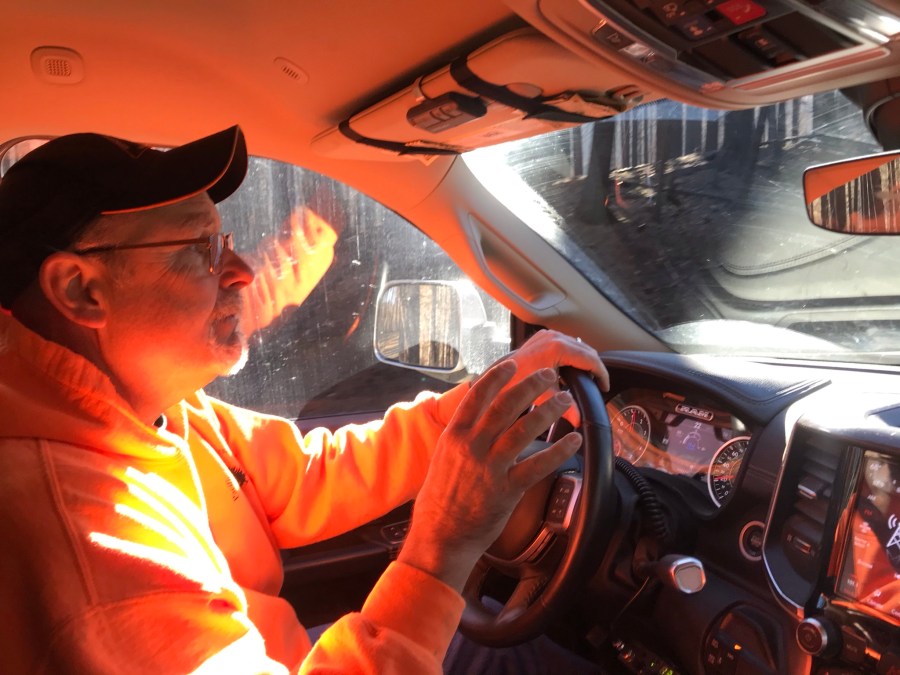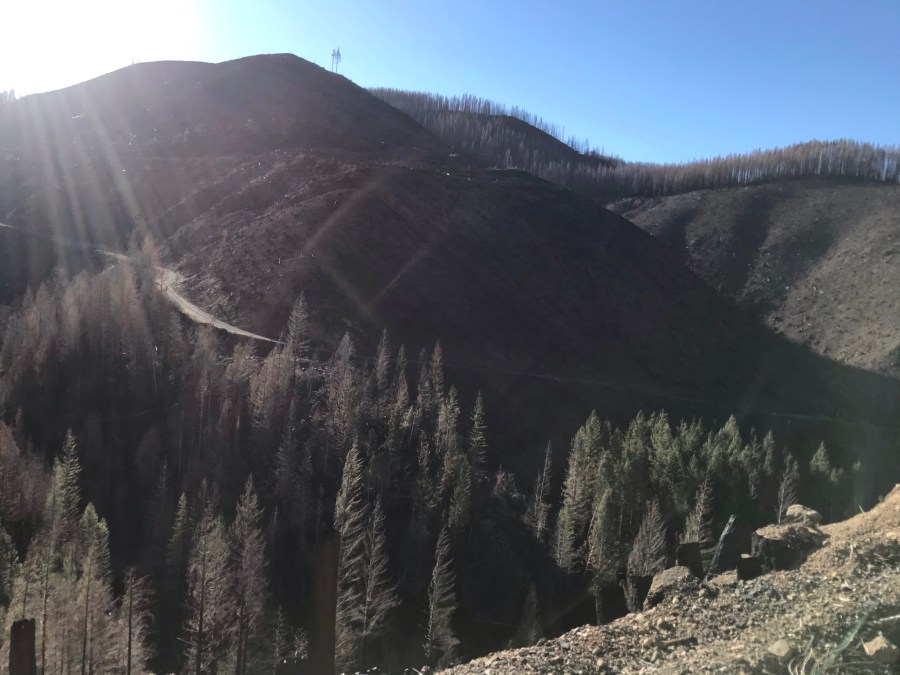PORTLAND, Ore. (KOIN) — As Brent Parries drives into the Molalla River Corridor, the devastation from the 138,000-acre Riverside Fire isn’t initially apparent. It’s not until he hits the 6-mile mark when the damage becomes noticeable.
“As you look down this corridor, you can see what the fire attacked and what it didn’t attack,” Parries said as he looked out the window of his pickup truck.

A few miles later, the landscape turns into what looks like a forest of standing tree skeletons, with nothing left on them but their branches.
The 2020 wildfires burned roughly 1.2 million acres in Oregon, according to the state’s office of emergency management. They left people homeless, destroyed timberland, and polluted the air for weeks. Now, in December, many are left pondering the best ways to prevent devastation like this in the future.
Parries is the co-owner of Pacific Forest Contractors, Inc. a logging company in Eagle Creek. He’s worked in the timber industry for more than 40 years and believes the standing, burned trees on the Bureau of Land Management property could be a problem in the future. He says they don’t just resemble matchsticks, they also have the potential to become matchsticks if they’re left on the land and not removed.
However, scientists feel otherwise.
The debate between scientists and loggers on the best ways to prevent wildfires is nothing new. Land management, the effects of climate change, and the methods of fighting fires are all issues being reexamined after a fire season that not only burned more than 1 million acres, but also destroyed entire towns in Oregon.
When Parries looks at the wildfire damage, one of the things that frustrates him most is the lack of land management on federally-owned property. When a fire burns privately-owned timber land, the burned trees are removed as quickly as possible and the ground is replanted with seedlings. When BLM or Forest Service land burns, it’s mostly left untouched, with the exception of crews removing some hazard trees or trees blocking roads.
He feels this is leaving the land primed for another fire in the future.
“See how thick this is? So this is the problem when you don’t manage. It becomes so thick, and it can be good and bad, you know, and it can protect itself, but if it does start on fire, it will all burn itself,” Parries said.

Parries said he’d like to see logging resume on federally-owned land. He believes the land has been mismanaged for the last few decades, since the northern spotted owl was listed as a threatened species under the Endangered Species Act in 1990 and all federal timber sales were prohibited.
While Parries sees logging as a solution to preventing such intense fires, others see it as a problem.
Erik Fernandez is the program manager of Oregon Wild, an organization that works to protect the state’s wildlands. In a panel hosted in October, Fernandez said evidence does not support the argument that logging helps prevent wildfires. In the Riverside Fire’s case, he said it’s possible past logging actually fed the fire.
“Over the entire fire area, 60% had been logged, so more than half the acres had been logged at least once,” Fernandez said.
He said another massive fire, the Holiday Farm Fire, which burned east of Eugene, also burned on heavily-logged timber land. He pointed out that the Thielsen Fire, near Diamond Lake, was not primarily burning on logged timber land and grew to less than 10,000 acres, making it significantly smaller than both the Riverside and Holiday Farm fires.
However, Dr. John Bailey, a forestry professor at Oregon State University, said comparing wildfires isn’t as simple as Fernandez makes it out to be. He said they’re all different and there are more factors to consider than whether the land is logged or not, such as the terrain, the elevation, the fuel beds, and the weather conditions.
“It’s like comparing kids in a classroom. Yeah, they’re all in the classroom, they’re all being exposed to the same teacher, but… there are limits to how many comparisons you can make,” Bailey said.
Another factor scientists are focusing on is climate change and its role in causing wildfires.
Dr. Erica Fleishman, director of the Oregon Climate Change Research Institute at Oregon State University, says climate change is an enabling circumstance. It’s not the only thing to blame for the fires, but it is making it easier for them to start.
“Plants are becoming very thirsty and thirsty plants burn,” Fleishman explained.
OCCRI’s most recent climate assessment report, published in January 2019, says Oregon continues to warm in all seasons, in part due to human activity. It states that fire is the most obvious impact of climate change in the West in recent years.
The report notes two other years when more than 1 million acres of wildland across the state burned, 2002 and 2012. The year 2012 was one of the warmest on record.
“None of the years with above-average area burned were near normal in seasonal temperature and precipitation continue to be influenced by warming temperatures and longer fire seasons,” the report states.
However, there are also years like 2003 and 2009 that record the top 10 warmest July through Septembers on record but had relatively small areas of wildfire activity.
Fleishman said it’s important to note that the massive wildfires that occurred in Oregon in 2020 are not unheard of. She said every 100 to 400 years there are intense fires in the wetter parts of Western Oregon.
A new study from Portland State University published in December 2020 shows that wildfires like the Riverside Fire that burned in the Molalla River Corridor will likely become larger and more frequent by mid-century under a warming climate.

“All climate and baseline scenarios illustrate that extremely large, intense fires are plausible, and that they will become more plausible under hotter and drier climate scenarios. The range of plausible impacts to mid-century fire regimes should be cause for managers and planners to adopt robust approaches to climate adaptation and risk mitigation,” the study states.
Already, firefighters are adapting their methods due to warmer weather conditions.
“The 21st century climate is rapidly ending the effectiveness of our 20th century firefighting strategies and tactics,” said Dr. Timothy Ingalsbee, executive director of Firefighters United for Safety, Ethics & Ecology. He spoke on the Oregon Wild panel in October.
He said aggressive firefighting is becoming more dangerous to firefighters and more expensive to taxpayers and isn’t effective at stopping fires.
Parries, the long-time logger, sees it from a different perspective. He believes if the government and government-funded fire crews were more proactive in fighting fires as soon as they started, less damage would occur and more money could be saved in the long run. He believes fire should be extinguished as quickly as possible.
“So there’s proactive and there’s reactive and proactive costs money, but reactive costs a lot more money and this is exactly what happened,” he said.
Parries says this year’s fires are a perfect example. He said some of them were burning and little or no firefighting was being done to extinguish them. When the Labor Day wind storm happened, suddenly the fires were a much greater threat.
The U.S. Forest Service told KOIN 6 News that they never simply “allow” wildfires to burn. They’re always suppressing and monitoring them in some way. Sometimes the terrain is too rugged to access the fire on foot immediately and if that’s the case, they’ll try to drop water on the fire from aircraft.
On its website, the Forest Service says recent science has changed the way they think about wildland fire. They’ll still try to suppress it, especially when it threatens people and communities, but they understand it has a role in nature.
From a scientific standpoint, Fleishman says allowing fires to burn can be beneficial to an ecosystem. Forests have experienced wildfires for thousands of years and sometimes suppressing it is only delaying the inevitable and manipulating the natural pattern.
Although it’s difficult to pinpoint what, exactly, will prevent cataclysmic wildfires in the future, most experts say it depends on the changes communities and lawmakers want to make. Legislators will need to decide if more land management will make Oregon less susceptible to fire. Timber land owners might need to reassess their own management practices, and communities will need to think more about their defensible space and about the wildland-urban interface.
Scientists and loggers alike are hoping these natural disasters won’t continue to impact future generations, but they have vastly different ideas on what changes will improve the outlook in decades to come.
“As Oregonians, as Americans, we need to work together for our large landscapes as well to make them more resistant and resilient as we move forward into a relatively uncertain future,” Bailey said.